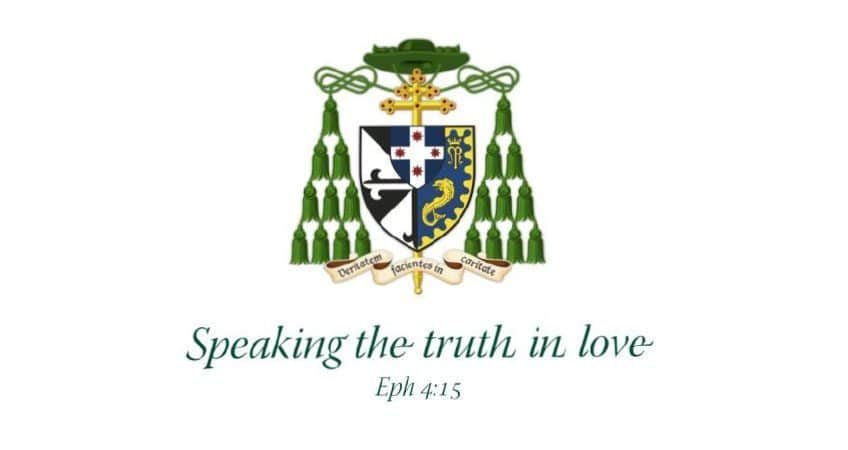HOMILY FOR VOTIVE MASS OF THE BLESSED VIRGIN MARY

Basilica di Santa Maria Maggiore, Rome
Three great and related ideas inspire and compete for the soul today: Christianity, Islam, and Secularism. Christianity, that is, faith in the person and Gospel of Jesus Christ, Son of God and son of Mary, is heir to Judaism, became the basis of a new Western civilization, and drove a great missionary endeavour that brought faith and worship, education and welfare, health and aged care, and pastoral care of many kinds to the ends of the earth.
Islam is a cousin of Christianity, and the family resemblance includes honouring God first, Abraham and Jesus as prophets, and Mary as the Virgin-Mother; but its faithful do not own that Jesus is God or that His mother could help anyone. Peaceable Muslims deplore violence and disown those threatening the security of our world. But today’s persecutions in the Middle East echo the days when Christians were driven out or underground, Sts Peter and Paul killed by crucifixion and beheading, and their bodies laid to rest at sites none could have guessed would one day sport great basilicas.
The other cousin of Christianity is the Enlightenment religion, Secularism, which also shares a great deal with Christianity, such as respect for human dignity, reason and rights; yet its faithful deny that Jesus is God and, indeed, that anyone is. In its fanatic guise it would kill believers and banish all faith from public and ultimately private life; in its milder forms it colonises believers and their institutions and replaces religious values with materialism and consumerism.
Much might be said about these three cousins, Christianity, Islam and Secularism, their family resemblances, differences and tensions. Strains of each have often coexisted peacefully and collaborated in various ways; while extremist versions have sometimes threatened the security of all. This morning I’d like to explore the thought that the Australian version of Mary is the contest point for all three…
In this great basilica Mary is honoured, second only to God, under the title of Salus Populi Romani, and her miraculous image above the altar of this Borghese Chapel was supposedly painted by St Luke using the wooden table of the Holy Family. We know it from the copy that travelled around Australia as the World Youth Day icon. Here she is also known as Saint Mary of the Crib and Our Lady of the Snows. Pius V, who is buried over there and who proves Dominican bishops can be saints, introduced into the Roman Calendar the feasts of the Dedication of St Mary Major and of Our Lady of Victory (and of the Holy Rosary).
Amidst serious tensions between Christianity and her cousin Islam – in the form of the Ottoman empire – Pius forged the Holy League of Catholic states to take a stand at the Battle of Lepanto on 7 October 1571. The combined Christian forces under Don John of Austria were terribly outnumbered, the Italian peninsula seemed fated to be overrun, and the Church doomed to annihilation. Pius called upon all Europe, including the subjects of the heretic queen Elizabeth of England whom he had recently released from allegiance to her, to fast and pray the Rosary for the peace and security of Christendom. At the very moment that the Battle of Lepanto ended, he rose and went to a window, gazing toward the East, and cried out, “Forget our meeting: our job now is to thank God for the victory He has given our Christian forces!”
In the nineteenth century, when Christianity’s other cousin, Secularism – in the form of the Napoleonic army of the French Enlightenment – also sought to extinguish the Church, another Pope Pius (this time the Seventh) again called Europe to fast and pray the Rosary for peace and security. Pius had been imprisoned by Napoleon, but was liberated after the battle of Leipzig and made a triumphal re-entry to Rome on 24 May 1814. Following the Pionine tradition he rewarded the Virgin with feasts in the universal calendar, first of Our Lady of Sorrows and then of Our Lady Help of Christians. The woman whose litany began with the biblical authors naming her ‘the Virgin with Child’, an archangel calling her ‘Full of Grace’ or ‘Most Highly Favoured’, and a cousin who identified her as ‘Most Blessed Mother of the Lord’, now had four more titles, the crown of them ‘Help of Christians’ (Lk ch. 1).
So in the eras of Pius V and Pius VII Mary was the intersection point between Christianity and Islam, and Christianity and Secularism. Her Aussie title Help of Christians hints at the principal challenges for Christianity in our contemporary world: persecution and exclusion, in the name of religion or irreligion, attempts to convert people from the faith of our fathers or to inoculate them to receiving and transmitting it. Like squabbling siblings, Christianity, Islam and Secularism can seem doomed to emphasize the differences between them and demonstrate intolerance to such differences and to their adherents.
Yet in some times and places the same cousins have managed to coexist peacefully. Isaiah prophesied that instead of trying the patience of God and man, we should recognize the signs of God-with-us (Isa 7:10-14). Instead of fighting kinsmen of our own or related faiths, we should go to their aid. Christianity and Islam can be good cousins to each other, as Mary in our Gospel models cousins collaborating and praising God (Lk 1:39-47).
Friendship is also possible between Christians and seculars, as demonstrated by the long collaboration between Church and state in our country in areas such as education and healthcare. We warmly receive all comers to our institutions, for ultimately Christianity has no enemies: every human being is an image of God and so our potential friend. There are, in a sense, but two faiths, those who are Christians and those yet to be, and we can will no ill to either. Christ commands us to love our enemies, then count them neighbours, then make them friends, then call them siblings, and finally own them as our other selves, making their good our own.
The Woman in whose basilica we gather challenges us regarding the three great rivals for modernity’s soul: not to overcome through trampling or shouting down the other; but to conquer supposed enemies by turning them into friends. Though she has accumulated many titles, artworks and dresses down the ages, the Woman’s greatest title is not Victress but Mother, her greatest symbol not a sword in hand or a sceptre, but a Baby, offered to all to see, hear, love. Threatened often through the centuries, instead of becoming demoralised, embittered, or vengeful, Christians have fasted and prayed to this Helper of Christians.
As brother bishops in a time of great challenge, we pray for something of St Pius V’s wisdom and courage, and we reconsecrate our nation and her chief pastors to the protection and guidance of this basilica’s patron:
Salus Populi Romani et ubique – pray for us.
Queen of the Most Holy Rosary – pray for us
Our Lady Help of Christians – pray for us
INTRODUCTION TO VOTIVE MASS OF THE BLESSED VIRGIN MARY
Basilica di Santa Maria Maggiore
Welcome dear brothers and friends to Pope Francis’ favourite Roman Church, where he so often prays, as we give thanks for our truly graced meeting with him yesterday and his ministry among us. This church was one of the first built in honour of Mary in the immediate aftermath of the Council of Ephesus, which in 431AD proclaiming her Mother of God in response to popular demand, as Pope Francis reminded us. There are mosaics here going back to that time and other mosaics, pavement and Nativity scene from the thirteenth and greatest of centuries. The principal treasures are, of course, the Holy Crib of Christ and miraculous icon of Mary. On 5 August is celebrated the miracle of Our Lady making the Roman summer comfortable by sending snow: on that feast the congregation is treated to a cascade of white petals descending from the coffered ceiling. Let us ask that comforting mother to intercede for the Church of Australia and its pastors, as we repent of our sins.
Welcome dear brothers and friends to Pope Francis’ favourite Roman Church, where he so often prays, as we give thanks for our truly graced meeting with him yesterday and his ministry among us. This church was one of the first built in honour of Mary in the immediate aftermath of the Council of Ephesus, which in 431AD proclaimed her Mother of God in response to popular demand, as Pope Francis reminded us. There are mosaics here going back to that time and other mosaics, pavement and Nativity scene from the thirteenth and greatest of centuries. The principal treasures are, of course, the Holy Crib of Christ and miraculous icon of Mary. On 5 August is celebrated the miracle of Our Lady making the Roman summer comfortable by sending snow: on that feast the congregation is treated to a cascade of white petals descending from the coffered ceiling. Let us ask that comforting mother to intercede for the Church of Australia and its pastors, as we repent of our sins.

